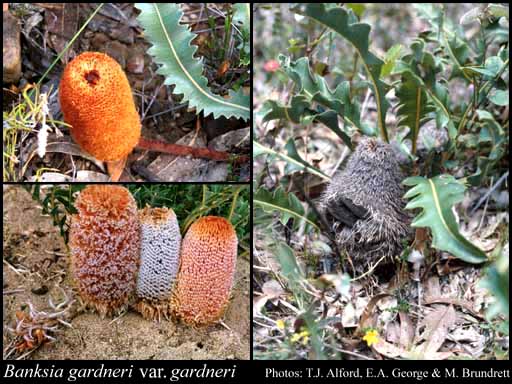- Conservation Code
- Not threatened
- Naturalised Status
- Native to Western Australia
- Name Status
- Current
Prostrate shrub, 0.1-0.3 m high, leaves deep green above, pinnatipartite (lobes 1-3 cm long). Fl. orange-brown, Sep to Nov. Grey, yellow sand & lateritic gravel.

Scientific Description
Prostrate shrubs, 0.1-0.3 m high; branchlets hairy. Leaves petiolate, alternate, 210-330 mm long, 20-40 mm wide, hairy; petiole 35-110 mm long; lamina flat, once divided, pinnately divided, deeply divided, with 8-21 lobes on each side, the margins flat. Inflorescences tomentose (with matted or tangled, soft, woolly hairs) or hirsute (with long, rough and coarse hairs), orange or brown; innermost bracts 10-15 mm long, hairy. Perianth 16-18 mm long, hairy, all over, limb apex hirsute (with long, rough and coarse hairs), without awns; pistil 19-21 mm long, curved, style glabrous. Follicles hairy, hirsute (with long, rough and coarse hairs), elliptic, 23-40 mm long. Flowers in September, October or November. Occurs in the South-west (SW) Botanical Province(s), in the Avon Wheatbelt (AW), Jarrah Forest (JF), Mallee (MAL) or Esperance Plains (ESP) IBRA subregion(s).
Distribution
- IBRA Regions
- Avon Wheatbelt, Esperance Plains, Jarrah Forest, Mallee.
- IBRA Subregions
- Fitzgerald, Katanning, Southern Jarrah Forest, Western Mallee.
- Local Government Areas (LGAs)
- Albany, Broomehill-Tambellup, Cranbrook, Denmark, Gnowangerup, Jerramungup, Plantagenet.